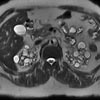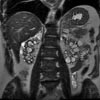Elevated Hematocrit in Man Receiving Hemodialysis
A 50-year-old man with end-stage renal disease secondary to long-standing hypertension had an elevated hematocrit and progressively increasing hemoglobin levels. For the past 7 years, he had been receiving hemodialysis 3 times a week. He denied headache, flushing, easy bruising, bleeding, nausea, vomiting, chest pain, dyspnea, and other symptoms. He was not receiving exogenous erythropoietin.

Figure 1 –
This cross-sectional T2-weighted MRI image of the abdomen from the patient's 2006 scan shows bilateral replacement of the kidney parenchyma by cysts of various sizes. No residual kidney tissue is visible.

Figure 2 –
This sagittal T2-weighted image from the same scan also shows renal cysts of various sizes replacing the renal parenchyma.
A 50-year-old man with end-stage renal disease secondary to long-standing hypertension had an elevated hematocrit and progressively increasing hemoglobin levels. For the past 7 years, he had been receiving hemodialysis 3 times a week. He denied headache, flushing, easy bruising, bleeding, nausea, vomiting, chest pain, dyspnea, and other symptoms. He was not receiving exogenous erythropoietin.
History. The patient had had a positive result on a tuberculin skin test about 10 years earlier and received appropriate prophylaxis. He had undergone arteriovenous (AV) fistula placement in 1999 and back surgery and an appendectomy in the 1980s. His medications included hydralazine, 75 mg every 6 hours; amlodipine, 10 mg qd; calcium carbonate, 1000 tid; and metoprolol, 50 mg bid. He had no drug allergies; however, aspirin and warfarin had caused upper GI bleeding. His mother and sister both died of breast cancer, but he had no family history of kidney disease or blood dyscrasia. He had smoked 1 pack of cigarettes a day for 35 years; he denied use of alcohol or illicit drugs.
Physical examination. The patient weighed 107.4 kg (263.3 lb). Heart rate was 97 beats per minute; blood pressure, 85/64 mm Hg; and oxygen saturation, 96% on room air. Pupils were reactive bilaterally with pink conjunctiva. Mucous membranes were moist. There was no jugular venous distention, and his heartbeat was regular, with no murmurs. Lungs were clear. Abdomen was soft and nontender. No abdominal or flank masses were found. An AV fistula was noted in the left upper extremity; there was no edema in the lower extremities.
Laboratory results. White blood cell count was 8300/µL; hemoglobin level, 16.5 g/dL with hematocrit, 48.6%; and platelet count, 202,000/µL. Results of a chemistry panel included the following levels: blood urea nitrogen, 45 mg/dL; creatinine, 10.3 mg/dL; calcium, 7.7 mg/dL; albumin, 4.6 g/dL; total protein, 9.9 g/dL; alkaline phosphatase, 393 U/L; alanine aminotransferase, 16 U/L; and aspartate aminotransferase, 66 U/L.
Plasma erythropoietin level was elevated at 40.5 mU/mL. Reticulocyte count was 2.5%, with an iron level of 47 µg/dL, a total iron-binding capacity of 275 µg/dL, and a saturation iron binding capacity of 17%.
Carboxyhemoglobin level was 3.5%. Results of pulmonary function tests were otherwise normal.
Imaging studies. A report of an MRI scan of the patient's abdomen performed in 2002 described numerous hemorrhagic and nonhemorrhagic renal cysts bilaterally. The largest of these, on the right kidney, measured 3.5 cm in diameter.
A recent (2006) MRI scan of the abdomen showed numerous well-defined intraparenchymal and exophytic cysts scattered diffusely throughout both kidneys (Figures 1 and 2). The largest, in the mid-pole of the anterior right kidney, measured 2.9 x 2.8 x 2.9 cm. Compared with the 2002 study, the number of cystic lesions had increased markedly; very little renal parenchyma was visible. Some of these cysts were hemorrhagic; none showed abnormal enhancement.
ERYTHROCYTOSIS: AN OVERVIEW
Erythrocytosis, or polycythemia, is characterized by an elevated red blood cell mass. It may result from increased proliferation of erythrocyte progenitors or from abnormal erythrocyte regulation. Clinically, it usually manifests as hemoglobin levels above 17.7 g/dL in men or 15.7 g/dL in women and a hematocrit greater than 51% in men or 48% in women. Symptoms of the hyperviscosity characteristic of erythrocytosis may include headache, dizziness, light-headedness, a congested sensation, and worsening of exercise tolerance.1 Include in the workup determination of serum erythropoietin level, measurement of red cell mass and plasma volume, and determination of oxygen saturation.2
CAUSES OF ERYTHROCYTOSIS
Erythrocytosis may represent contraction of plasma volume, an appropriate physiological response to inadequate tissue oxygenation, a primary clonal disorder (such as polycythemia vera), or inappropriate stimulation of erythrocyte production caused by autonomous secretion or exogenous administration of erythropoietin. Measurement of serum erythropoietin levels is helpful in determining the cause.
Smoking. This is the most common cause of secondary polycythemia. Smoking-related erythrocytosis results from a carboxyhemoglobin-induced increase in red blood cell mass with a concurrent decrease in plasma volume. The carbon monoxide that enters the bloodstream when cigarette smoke is inhaled binds to heme iron with an affinity 200 times greater than that of oxygen and forms carboxyhemoglobin. As carboxyhemoglobin levels increase, the functional hemoglobin in the blood is reduced proportionally and oxygen delivery to tissues is impaired.3 Carboxyhemoglobin levels of greater than 4% can cause erythrocytosis.1
Smoking as few as a pack of cigarettes a day can raise the hematocrit, although heavier use is usually involved. Hemoglobin levels return to normal in most patients after they quit smoking.4 In patients with chronic renal failure, however, a mild elevation in carboxyhemoglobin is not alone sufficient to induce erythrocytosis.5
Inappropriate erythrocytosis. This can result from autonomous secretion of erythropoietin by certain tumors, such as hepatocellular carcinoma and renal cell carcinoma. It can also result from local renal ischemia caused by mass lesions (such as tumors), hydronephrosis, or cystic disease.1 On occasion, inappropriate erythrocytosis occurs when patients on dialysis are given more than the recommended amount of recombinant human erythropoietin.6 An elevated erythropoietin level is a clue to the presence of inappropriate erythrocytosis.
ERYTHROCYTOSIS IN CHRONIC KIDNEY DISEASE
Moderate to severe anemia develops in most patients with chronic renal disease. A decrease in the production of red blood cells is related to impaired synthesis of erythropoietin by the diseased kidneys. The amount of erythropoietin produced decreases with increased excretory failure. Ambient hemoglobin levels in patients with end-stage renal disease who are not receiving exogenous erythropoietin are usually in the range of 5 to 7 g/dL.7
In some patients with renal disease, erythrocytosis can occur. End-stage kidneys are still capable of augmenting the secretion of biologically active erythropoietin, and erythropoietin production may be paradoxically increased in the presence of renal ischemia caused by space-occupying lesions such as tumors or cysts, renal artery stenosis, hydronephrosis, polycystic kidney disease, or diffuse renal parenchymal disease.8
In patients who have not undergone kidney transplantation, elevated erythropoietin levels usually result from autonomous or inappropriate renal secretion. Long-term hemodialysis may cause a progressive increase in renal volume and an increased incidence of cystic kidney disease. Erythropoiesis-stimulating activity has been demonstrated in the fluid of renal cysts, where erythropoietin is produced by the epithelial cells that line them. Unregulated production of erythropoietin, such as that seen in this patient, can occur as the proliferation of the endothelial cells lining the cysts reaches adenomatous proportions. Polycythemia has resolved following drainage or resection of renal cysts, which further implicates the cysts as a locus of erythropoietin production.7,9
MANAGEMENT OF ERYTHROCYTOSIS SECONDARY TO CYSTIC KIDNEY DISEASE
Treatment of polycythemia caused by cystic kidney disease may include drainage or resection of large cysts, removal of renal tumors, or nephrectomy of native kidneys at the time of transplantation. Phlebotomy with hemodialysis to maintain a hematocrit under 48% in men or 45% in women may also be effective. However, because phlebotomy may deplete existing iron stores, iron supplementation is necessary.4,10
Because this patient's polycythemia was borderline and he had no symptoms, phlebotomy was not mandatory. However, he did undergo intermittent phlebotomy during dialysis as a precautionary measure. When he returned 1 month later for follow-up, his hemoglobin level was 14.9 g/dL. He was counseled to stop smoking and remains on the kidney transplant list.
Key Points for Your Practice
- A hematocrit greater than 51% in men or greater than 48% in women requires evaluation.
- The workup of an elevated hematocrit includes measurement of the serum erythropoietin level and appropriate imaging studies.
- Exclude secondary causes of polycythemia, such as carboxyhemoglobinemia, renal masses, and renal artery stenosis.
- Polycystic kidneys in patients receiving long-term hemodialysis may result in elevated levels of erythropoietin and consequent erythrocytosis-in contrast to the anemia usually seen in patients with renal failure.
- Management of secondary polycythemia includes smoking cessation if appropriate, phlebotomy with iron supplementation in symptomatic patients, and removal of renal lesions if appropriate.
References:
REFERENCES:1. Golde DW, Hocking WG, Koeffler HP, Adamson JW. Polycythemia: mechanisms and management. Ann Intern Med. 1981;95:71-87.
2. Tefferi A, Spivak JL. Polycythemia vera: scientific advances and current practice. Semin Hematol. 2005;42:206-220.
3. Smith JR, Landaw SA. Smokers' polycythemia. N Engl J Med. 1978;298:6-10.
4. Hoffman R, Baker KR, et al. The polycythemias. In: Hoffman R, Benz EJ, Shattil SJ, et al, eds. Hematology: Basic Principles and Practice. 4th ed. New York: Churchill Livingstone; 2004.
5. Shalhoub RJ, Rajan U, Kim VV, et al. Erythrocytosis in patients on long-term hemodialysis. Ann Intern Med. 1982;97:686-690.
6. Singh AK, Szczech L, Tang KL, et al. Correction of anemia with epoetin alfa in chronic kidney disease. N Engl J Med. 2006;355:2085-2098.
7. Caro J, Brown S, Miller O, et al. Erythropoietin levels in uremic nephric and anephric patients. J Lab Clin Med. 1979;93:449-458.
8. Lezrek M, Fassi-Fehri H, Badet L, et al. Remission of erythrocytosis and hypertension after treatment of a giant renal cyst. Urology. 2002;60:164.
9. Heller DS, Hurlet A, Bhattacharya N, Methratta ST. Polycythemia secondary to multiloculated renal cyst in a child. J Ped Surg. 2002;37:1491-1492.
10. Hadimeri H, Norden G, Friman S, Nyberg G. Autosomal dominant polycystic kidney disease in a kidney transplant population. Nephrol Dial Transplant. 1997;12:1431-1436.